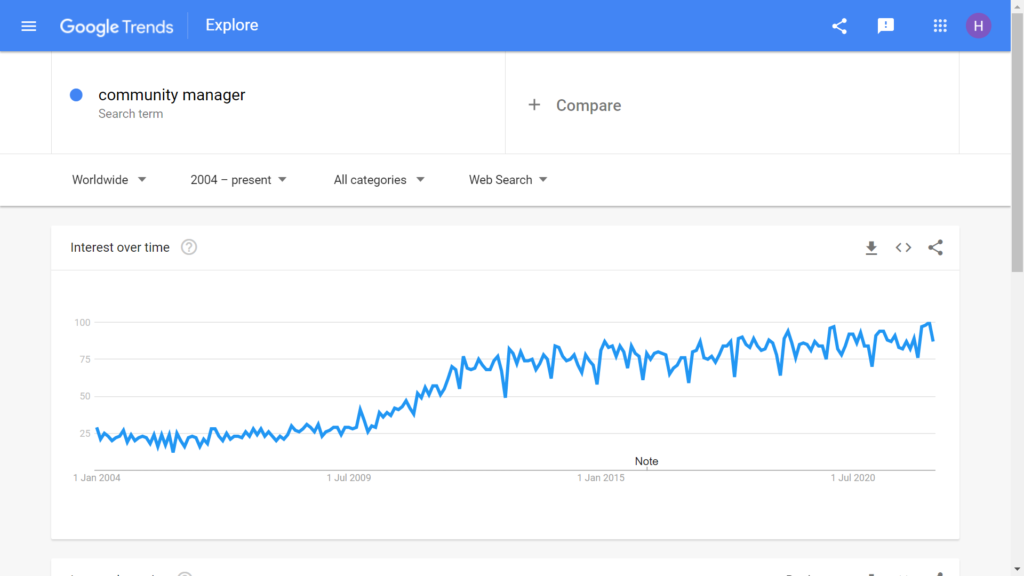Typically, online communities are synonymous with Slack, Facebook groups, LinkedIn, or Telegram, in which members engage with each other, discuss topics relevant to their interests or careers, and share knowledge. But brands are starting to figure out how to grow a community and its members into brand advocates and create profitable ventures.
Communities now have strategic importance in boardrooms as they influence company values and marketing strategies. This has nurtured the growth of community-led businesses. If you aren’t already in the know, you might be wondering how you can go about creating an online community, what community management is, and what it looks like for your brand.
The emerging importance of communities in strategic business decision-making is driving the formation of community management departments and roles within companies and brands. Knowing this, I too jumped on this community-led business bandwagon with Merrative. Using my experience in building an online community, I will introduce you to what online community management is.
- What Is Online Community Management?
- Why Is Online Community Management Important?
- Using Community Management Software
What Is Online Community Management?
Online community management involves building, strategizing around, and growing a community that exists online (such as in a Slack group, a subreddit, or a forum). It includes any deliberate efforts to build an audience around your brand and nurture a community.
You may not undertake active community management or building efforts, but that doesn’t stop people from interacting with your brand and your online presence. An online community is visible across all corners of the internet. This includes social media followers, blog commenters, newsletter subscribers, online forum members, YouTube viewers, and more. In fact, an online community includes anyone who interacts organically with your brand and your content across any platform where you publish content.
Across each of these channels where you interact with users, it’s important to maintain a consistent way of representing your brand. Brands need to have standards for voice and tone, writing style, colors, and more. It’s also a good idea to bring your brand to life by giving it a relatable personality that fits with your branding guidelines.
This is part of the goal of online community management—to present your brand as a real person that interacts seamlessly with the online community.
For example, TED has grown much beyond its signature conferences. Its TEDx program enables other organizations, communities, and individuals across 150 countries to organize TED-like experiences. This helps them spread their impact beyond its reach. It also encourages discussion of TED Talks in small local groups via the TED Circles program.
Community building has helped TED form a live brand persona and give audiences a reason to stay connected. This increases their impact via direct or indirect interaction with content consumers and their audience at large.
What Does A Community Manager Do?
Community managers are responsible for building, maintaining, and growing digital relations between your brand and your community. They might be part of the broader marketing team, or they may be part of a specific community management department.
A majority of their work involves personifying your brand’s identity. They use this identity to communicate with the larger community. They also provide any necessary or relevant feedback from community members and customers to branding, marketing, product, and support teams.
The community management industry is steadily maturing. Today, 88% of online communities have one dedicated community manager, and at least two full-time community members are present in 67% of companies.
For two decades, you can see a consistent increase in the popularity of ‘community manager’. Looking at industry trends, I am expecting the growth to continue in the future.

Community manager's responsibilities include the following:
Building Community
Here, community managers focus on aligning the community with the brand's marketing strategy. Keeping the company goals in mind, they determine the basics of how the community operates.
This involves choosing platforms, drafting community guidelines and values, and setting and tracking measurable KPIs. This also involves strategizing around community engagement initiatives like support programs, rituals, gamification, and more.
Maintaining Community
Successful community managers create and implement strategies to maintain active engagement across multiple platforms and throughout the community.
This includes maintaining comments sections, answering direct messages on social networks, and creating content to drive engagement (such as Instagram stories, forum posts, polls, TikTok hashtag challenges, and tweet threads).
Growing Community
Here, community managers optimize the community to encourage growth. The aim is to set up and improve community growth metrics. This might include increasing sign-ups, engagement rates, newsletter subscriptions, and more, depending on your goals for your community.
Specific tactics could include setting up giveaways, optimizing onboarding, or incentivizing referrals, and boosting word-of-mouth-ability.
Online Community Management On Social Media
Social media management forms a crucial element of community building. Many social media marketing experts speak about how important it is to be ‘relatable’ with your brand's social media management. One cannot help but roll their eyes and say—it's easier said than done, right?
Because people generally feel comfortable engaging in communities, it’s important to adopt a social media management strategy that treats your social media audience like a community of customers or members.
Social media platforms have also enabled customers to voice their dissatisfaction. Customers and community members expect brands to be a message away for customer support or queries.
Here are 4 key benefits that effective community management can bring as you’re building brand communities on social media:
- Customer acquisition: Social media is a great place to increase brand awareness. Influencer collaborations can help boost your brand's reach. While gaining followers is great, you also need to convert them into new customers. Have a customer acquisition strategy in place that drives followers to your funnel. Strategic calls-to-action can help boost sign-ups, newsletter subscriptions, demo bookings, or special offer purchases.
- Customer engagement: Every social platform provides posting formats and tools to engage followers. Use them to create community rituals and initiatives that become a part of your audience’s usual scroll. Some effective examples include monthly contests, live sessions, polls, or group chats. Don’t forget to actively interact as you go.
- Customer Care: Customer complaints via social media have increased by 8 times since 2014. You should be proactive with fast responses and instant solutions and have a feedback mindset. By being responsive, you can publicly showcase your customer service in comments. This helps maintain the brand’s reputation while also avoiding any further escalation.
- Brand advocacy: Your analytics dashboard will show you engaged followers and super fans. Identify these influencers (or micro-influencers) and create opportunities for them to associate with your brand at a deeper level. For example, design brand ambassador programs and affiliate programs, nurture user-generated content or take testimonials.
Social media platforms can form a good community base, as your existing audience likely already hangs out there. You may also use community builder software to DYI your own online community space. Use your community for social listening and feedback. Showcase your brand voice with every interaction in your social media community.
Why Is Online Community Management Important?
Knowing what online community management is helps brands make better business decisions that benefit their target audience.
Community management facilitates an ecosystem where community members and audiences can connect, share, and grow together with you.
Other remarkable benefits of community management include:
- Fundraising: As the famous saying goes—your network is your net worth. Building community also creates a network of people who interact with your brand. If you play it right, your community can become your source of capital through tactics such as crowdfunding. Loyal and engaged community members can often help you fundraise and can provide investments, as well as provide the necessary social proof to other potential investors.
- Business transformations: Major changes in your business (such as logo changes, business model changes, and pricing changes) can change how the customers perceive the brand. Since community managers help personify the brand identity, they can also smoothen such transformations. For example, Adobe adopted the community approach to humanize their enterprise software business image. They nurtured a design community via events, merchandising, and community-driven customer support.
- More revenue: You can monetize your community in a variety of ways, such as creating paid membership subscriptions, selling advertising, offering sponsorship opportunities for community events from non-competing brands, or creating paid courses.
Using Community Management Software
By using community management software, you can manage the nitty-gritty of community building. Software also helps you gain clarity on how your growth metrics and KPIs are performing. Using such insights, you can make better business decisions. Depending on the software you choose, it also enables community managers to:
- Bring communications with stakeholders across channels into a single platform
- Centralize internal community management activities and decision making
- Track and analyze community engagement and growth
- Content creation, scheduling, and management
- Event creation and operations management
As you can see, using community management software reduces operational burden. It helps you automate repetitive tasks and optimize workflows.
Newer tools might be AI-powered and often offer integrations between all platforms where your community is present. For the early-stage communities, using Google Sheet templates, basic scheduling and analytics tools, and a CRM would suffice.
Building An Online Community Is Worth It
As a brand, you are likely already engaging in community-building activities such as replying to comments, event marketing, and content curation.
But having the ability to strategically manage your community can help you streamline these efforts. It will help you get results in the form of a solid brand with a loyal fan base.
If you’re new to online community management or struggling to maintain your community, here’s an insightful case study on growing community engagement by 400%.
Don’t forget to subscribe to the Indie Media Club newsletter for more on community building and management.
Ready for more? Here's a podcast worth a listen: How To Build The World’s Largest Theme Park Fan Site
Related Read:
Related List of Tools: Online Publishing Platforms For Digital Publishers
Also Worth Checking Out:


